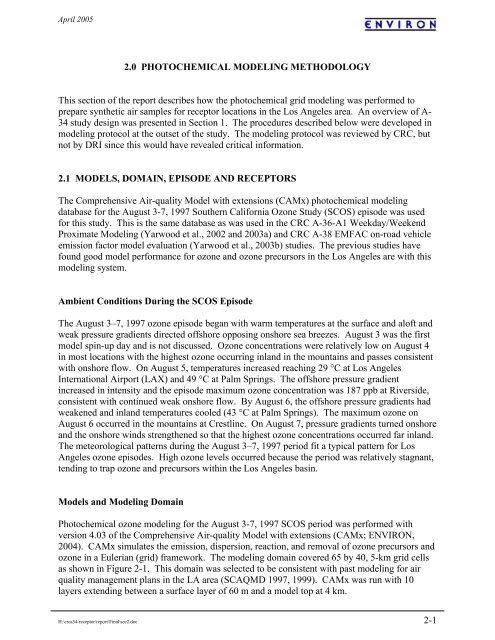CRC Report No. A-34 - Coordinating Research Council
CRC Report No. A-34 - Coordinating Research Council
CRC Report No. A-34 - Coordinating Research Council
Create successful ePaper yourself
Turn your PDF publications into a flip-book with our unique Google optimized e-Paper software.
April 2005<br />
2.0 PHOTOCHEMICAL MODELING METHODOLOGY<br />
This section of the report describes how the photochemical grid modeling was performed to<br />
prepare synthetic air samples for receptor locations in the Los Angeles area. An overview of A-<br />
<strong>34</strong> study design was presented in Section 1. The procedures described below were developed in<br />
modeling protocol at the outset of the study. The modeling protocol was reviewed by <strong>CRC</strong>, but<br />
not by DRI since this would have revealed critical information.<br />
2.1 MODELS, DOMAIN, EPISODE AND RECEPTORS<br />
The Comprehensive Air-quality Model with extensions (CAMx) photochemical modeling<br />
database for the August 3-7, 1997 Southern California Ozone Study (SCOS) episode was used<br />
for this study. This is the same database as was used in the <strong>CRC</strong> A-36-A1 Weekday/Weekend<br />
Proximate Modeling (Yarwood et al., 2002 and 2003a) and <strong>CRC</strong> A-38 EMFAC on-road vehicle<br />
emission factor model evaluation (Yarwood et al., 2003b) studies. The previous studies have<br />
found good model performance for ozone and ozone precursors in the Los Angeles are with this<br />
modeling system.<br />
Ambient Conditions During the SCOS Episode<br />
The August 3–7, 1997 ozone episode began with warm temperatures at the surface and aloft and<br />
weak pressure gradients directed offshore opposing onshore sea breezes. August 3 was the first<br />
model spin-up day and is not discussed. Ozone concentrations were relatively low on August 4<br />
in most locations with the highest ozone occurring inland in the mountains and passes consistent<br />
with onshore flow. On August 5, temperatures increased reaching 29 °C at Los Angeles<br />
International Airport (LAX) and 49 °C at Palm Springs. The offshore pressure gradient<br />
increased in intensity and the episode maximum ozone concentration was 187 ppb at Riverside,<br />
consistent with continued weak onshore flow. By August 6, the offshore pressure gradients had<br />
weakened and inland temperatures cooled (43 °C at Palm Springs). The maximum ozone on<br />
August 6 occurred in the mountains at Crestline. On August 7, pressure gradients turned onshore<br />
and the onshore winds strengthened so that the highest ozone concentrations occurred far inland.<br />
The meteorological patterns during the August 3–7, 1997 period fit a typical pattern for Los<br />
Angeles ozone episodes. High ozone levels occurred because the period was relatively stagnant,<br />
tending to trap ozone and precursors within the Los Angeles basin.<br />
Models and Modeling Domain<br />
Photochemical ozone modeling for the August 3-7, 1997 SCOS period was performed with<br />
version 4.03 of the Comprehensive Air-quality Model with extensions (CAMx; ENVIRON,<br />
2004). CAMx simulates the emission, dispersion, reaction, and removal of ozone precursors and<br />
ozone in a Eulerian (grid) framework. The modeling domain covered 65 by 40, 5-km grid cells<br />
as shown in Figure 2-1. This domain was selected to be consistent with past modeling for air<br />
quality management plans in the LA area (SCAQMD 1997, 1999). CAMx was run with 10<br />
layers extending between a surface layer of 60 m and a model top at 4 km.<br />
H:\crca<strong>34</strong>-receptor\report\Final\sec2.doc 2-1
















